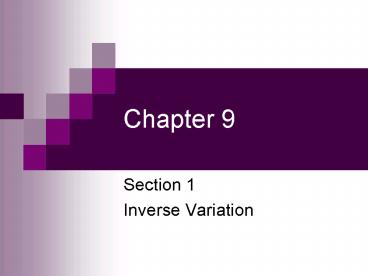Inverse Variation - PowerPoint PPT Presentation
1 / 18
Title:
Inverse Variation
Description:
Chapter 9 Section 1 Inverse Variation Direct Variation (from Ch. 2) Direct Variation a linear function defined by an equation of the form y = kx ... – PowerPoint PPT presentation
Number of Views:1310
Avg rating:3.0/5.0
Title: Inverse Variation
1
Chapter 9
- Section 1
- Inverse Variation
2
Direct Variation (from Ch. 2)
- Direct Variation a linear function defined by
an equation of the form y
kx, where k ? 0 - Constant of Variation is represented by k
- How would you solve for k?
- Notice that as x increases so does y
3
Identifying a Direct Variation from a Table
Remember
- For each function, determine whether y varies
directly with x. If so, find the constant of
variation and write the equation.
b)
a)
x y
1 4
2 7
5 16
x y
2 8
3 12
5 20
Since the ratios are not equal this is not a
direct variation. y does not vary directly with x.
Since the fractions are equal, the constant of
variation (k) is 4. The equation is y 4x.
4
Inverse Variation
- An inverse Variation is a function of the form
where k ? 0 - How would you solve for k?
- k yx
- Notice that if x increases, y decreases
5
Suppose that x and y vary inversely, and x
3 when y -5. Write the function that models
this situation.
- Write the general form
- Substitute the values of x and y
- Solve for k
- Put it in the general form
6
Suppose that x and y vary inversely, and x
0.3 when y 1.4. Write the function that models
the variation.
7
Suppose that x and y vary inversely, and x
7 when y 4. Write the function that models the
variation.
8
Each ordered pair is from an inverse variation.
Find the missing value.
- (2,4) and (6,y)
- (4,6) and (x,3)
9
Identifying Direct and Inverse Variations from
x-y charts
- Divide each pair to see if the relation is Direct
- Multiply each pair to see if the relation is
Inverse - If Neither work answer neither
10
Is the relationship between the variables in each
table a direct variation, an inverse variation,
or neither? Write the function to model the
direct and inverse variations.
x 0.5 2 6
y 1.5 6 18
A)
11
x 0.2 0.6 1.2
y 12 4 2
12
x 1 2 3
y 2 1 .5
13
Is the relationship between the variables in each
table a direct variation, an inverse variation,
or neither? Write the function to model the
direct and inverse variations.
x 0.8 0.6 0.4
y 0.9 1.2 1.8
A)
x 2 4 6
y 3.2 1.6 1.1
B)
x 1.2 1.4 1.6
y 18 21 24
C)
14
Combined Variations
- Combined Variations include direct and inverse
variations in more complicated relationships - Notice that all the general forms have a k, but
it is not mentioned in the words - DO NOT WRITE THE BULLETS BELOW
- Copy the chart on the next slide on a notecard
you will be able to use this on the test - Note that the variables and constants used are
examples these are guidelines for the questions
you will need to answer, not an all inclusive list
15
Combined Variation Equation Form
y varies directly with the square of x
y varies inversely with the cube of x
z varies jointly with x and y
z varies jointly with x and y and inversely with w
z varies directly with x and inversely with the product of w and y
16
Write the function that models each relationship.
Find z when x 4 and y 9
- z varies directly with the square of x and
inversely with y. When x 2, and y 4, z 3.
- Write a variation, using the chart if necessary.
Dont forget the k. - Substitute known values
- Solve for k
- Rewrite general variation substituting in the
number for k.
17
Write the function that models each relationship.
Find z when x 4 and y 9
- z varies directly with x and inversely with y.
When x 6 and y 2, z 15.
- z varies jointly with x and y. when x 2 and y
3, z 60.
18
Homework
- Workbook
- Practice 9.1 1-32 all
- Show all work, dont take the shortcut
- Remember that sometimes x and y are presented in
(x, y) format. Use your head and think of the
information given.































